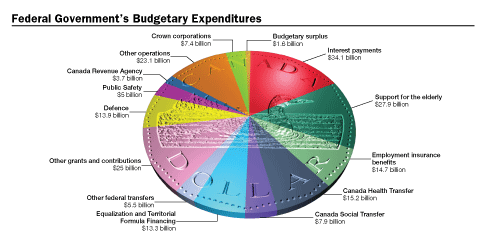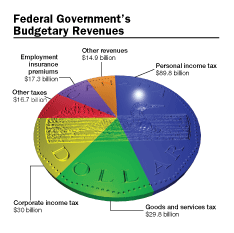|
|
Where Your Tax Dollar Goes
In the fiscal year ended March 31, 2005, Canada’s federal government collected $198.4 billion in taxes and other revenues. That represents a bit over 15 per cent of our country’s $1.3-trillion economy. This fanfold provides a quick overview of where that money went—and how it was raised.
About These NumbersThe federal government calculates its finances over a 12-month "fiscal year" that ends every March 31. This presentation is based on the Annual Financial Report of the Government of Canada for the most recent completed fiscal year, 2004–05. Where Your Tax Dollar Goes is updated annually, after the Government’s final financial results become available. Please note that numbers may not total 100 per cent due to rounding. |
1. Interest Payments
The largest single federal spending item in 2004–05 was interest payments on Canada’s public debt (that is, money borrowed by the central government over the years, which has not yet been repaid to the lenders). These payments—to institutions and people who hold federal bonds, treasury bills and other forms of the debt—cost $34.1 billion. That’s just over 17 cents of every tax dollar
2. Transfer Payments
Cash payments that go directly to individuals, to provincial and territorial governments, and to other organizations are called "transfers." There are three major categories of transfers. Combined, they made up more than half of all federal spending—just over 55 cents of each tax dollar ($109.6 billion).
Transfers to Persons
The biggest transfer category was Major Transfers to Persons. These direct payments to people cost about 211⁄2 cents of every tax dollar ($42.6 billion).
- This included payments to eligible elderly Canadians through Old Age Security payments, the Guaranteed Income Supplement and the Allowance for spouses. After interest on the federal debt, this support for seniors was the second largest spending item in the federal budget—14 cents of your tax dollar ($27.9 billion).
- The other major transfer to people was employment insurance (EI) benefits to eligible unemployed workers (including for periods of unemployment due to sickness, pregnancy, parental leave and caring for gravely ill or dying family members). And funding also went to programs that assist people to prepare for, find and maintain jobs. Altogether, EI payments cost about 71⁄2 cents of every tax dollar ($14.7 billion).
Support for Families and ChildrenIn 2004–05, the federal government also provided nearly $12 billion in direct cash payments to help low- and modest-income families—especially those with children—through the Canada Child Tax Benefit ($8.7 billion) and the goods and services tax (GST) credit ($3 billion). Since these payments are subtracted from ("netted against") personal income tax and GST revenues, they are not included in the spending calculations presented to Parliament in each year’s federal budget. |
Funding for Provinces
The federal government also funds several Major Transfers to Other Levels of Government. These payments—totalling almost $42 billion in 2004–05—help provinces and territories pay for health care, post-secondary education and other social services.
Since 1996, much of this support came through a single program, the Canada Health and Social Transfer. However, to improve transparency and accountability, the federal, provincial and territorial First Ministers agreed to divide this funding into two separate programs starting in 2004.
- The Canada Health Transfer in 2004–05 provided provinces and territories with cash support for health programs equal to more than 71⁄2 cents of each tax dollar ($15.2 billion).
- The Canada Social Transfer—to support post-secondary education, social assistance and other social programs—gave provinces and territories cash funding representing 4 cents of each federal tax dollar ($7.9 billion).
Further major transfers included the equalization and Territorial Formula Financing programs, which together equal more than 61⁄2 cents of every tax dollar ($13.3 billion). These are payments from Ottawa to less-affluent provinces, and to the three territories, to help them provide public services reasonably comparable to those that wealthier provinces can deliver.
There were also a variety of other federal transfers, such as funding to reduce medical wait times, for early learning and child care, and under an agreement with Newfoundland and Labrador and Nova Scotia about offshore resource revenues. Together, these helped boost transfer funding by almost 3 cents of each tax dollar ($5.5 billion).
Support for Health CareFederal support for health care goes beyond cash payments under the Canada Health Transfer, the equalization program, and initiatives such as the $4.2-billion Wait Times Reduction Fund. For example, in 1977 the federal government agreed to let the provinces take over a share of its taxes to supplement direct cash transfers. In 2004–05, these "tax points" added some $16 billion to provincial finances for programs such as health care. There is also direct health-related spending by the federal government itself, which contributed some $6 billion last year. This included funding for First Nations health services; health care for veterans; and programs for health protection, disease prevention, health information and health-related research. For more information, consult Total Federal Support for Health, Post-Secondary Education, and Social Assistance and Social Services (2004–05) on the Department of Finance Canada website at www.fin.gc.ca. |
Other Grants and Contributions
Other transfer programs by various federal departments provide funds to individuals, governments and other organizations and groups for specific public policy purposes.
In 2004–05, spending on these federal grants, contributions and subsidies added up to $25 billion, or just over 121⁄2 cents of each tax dollar. This included:
- Over $6 billion in transfers for First Nations and Aboriginal peoples (bringing total federal spending in this area to some $9 billion).
- Some $2.8 billion in assistance to farmers and other food producers.
- About $3.6 billion in foreign aid and other international assistance.
- Over $3.6 billion in support for research and development, infrastructure, regional development and assistance to businesses.
Further funding went to student assistance programs, health research and promotion, the arts, amateur sports, and multiculturalism and bilingualism.
3. Other Program Expenses
After transfers, the bulk of federal tax dollars went to cover the operating costs of government itself: the more than 130 departments, agencies, Crown corporations and other federal bodies that provide programs and services for Canadians.
In 2004–05, these operating costs (such as salaries and benefits, facilities and equipment, and supplies and travel) made up a bit under 27 cents of each tax dollar ($53.1 billion).
But a large share of this spending—close to 111⁄2 cents of each tax dollar—went to just three organizations.

Defence
First, spending by the Department of National Defence on Canada’s military forces last year made up 7 cents of each taxpayer dollar ($13.9 billion).
Public Safety
Next, operating costs of the Department of Public Safety and Emergency Preparedness were just over 21⁄2 cents of your tax dollar ($5 billion). This includes funding for the Royal Canadian Mounted Police, the federal prison system, and border traffic and security operations.
Canada Revenue Agency
And third, there was funding for the Canada Revenue Agency, which administers the federal tax system (and also collects personal income taxes for all provinces except Quebec). Its operations cost about 2 cents of each tax dollar ($3.7 billion).
Other Operations
A further $23.1 billion—just over 111⁄2 cents of each tax dollar—was spent on the operations of the other federal departments and agencies.
These included major departments such as: Environment; Fisheries and Oceans; Health; Human Resources Development; Industry; Justice; Natural Resources; Public Works; Transport; and Veterans Affairs.
As well, funding went to federal agencies such as the Canadian Food Inspection Agency, Parks Canada and the Canadian International Development Agency.
Paying for ParliamentOne of the smallest slices of federal operating spending goes to Parliament itself—the House of Commons, the Senate and the Library of Parliament. In 2004–05, the combination of salaries and benefits for Members of Parliament, Senators and parliamentary staff, and spending on facilities and services, totalled about $468 million. That’s about one-quarter of a cent of every tax dollar. |
Crown Corporations
The last portion of Other Program Expenses in 2004–05 went to Crown corporations (organizations owned directly or indirectly by the Government). This cost $7.4 billion, or a bit over 3.7 cents of your tax dollar. But the bulk of this funding went to just three organizations:
- The Canada Mortgage and Housing Corporation, which helps support home ownership and affordable housing, received $2.1 billion.
- The Canadian Broadcasting Corporation—our national television and radio networks—received $1 billion.
- Atomic Energy of Canada Limited recorded a $2.3-billion expense last year for environmental liabilities.
Funding was also provided to cultural organizations (including the National Gallery of Canada, the Canadian Museum of Civilization and the Canada Council for the Arts), to enterprises like VIA Rail, and to the Canadian Tourism Commission.
4. Budgetary Surplus
(Debt Reduction)
The remaining 0.8 cents of the 2004–05 tax dollar was the budgetary surplus—how much money was left after paying for all federal programs, operations and interest on the debt ($1.6 billion).
This surplus was not money available for future spending. Government accounting principles mean that any surplus at year-end automatically goes to help reduce the federal debt.
Together with other surpluses recorded in recent years, this has helped cut the federal debt by $63 billion. And lower debt means the Government and taxpayers are saving $3 billion a year in interest costs.
Where the Money Comes From
The federal government’s budgetary revenues came from a variety of taxes and other sources.
- Personal income tax is the biggest revenue source. In 2004–05, it provided $89.8 billion in federal funding. That’s more than 45 per cent of all federal revenues.
- Revenues from the goods and services tax provided $29.8 billion, or 15 per cent of total federal funds.
- Corporate income tax raised about $30 billion, just over 15 per cent of federal finances.
- A number of other taxes—such as non-resident taxes, customs import duties, energy taxes and excise taxes on alcohol and tobacco—made up $16.7 billion, or nearly 81⁄2 per cent of revenues.
- As well, employment insurance premiums, which are treated as part of general revenues, contributed $17.3 billion to federal finances, or 8.7 per cent of the total.
- And other revenues—such as earnings by Crown corporations and the sale of goods and services—provided the remaining $14.9 billion, or 71⁄2 per cent of total revenues. This included a one-time $2.6-billion net gain from the sale of the federal government’s remaining shares in Petro-Canada.

How Can I Get More Information?
A multimedia version of this document—which also includes direct links to other online material on federal finances—is available on the Internet at www.fin.gc.ca.
General information on the Government of Canada and its operations is available by phoning:
1 800 O-Canada (1 800 622-6232)
1 800 926-9105
(TTY for the speech and hearing impaired)
You can also obtain copies of this fanfold and other documents prepared by the Department of Finance Canada from the:
Distribution Centre
Department of Finance Canada
Room P-135, West Tower
300 Laurier Avenue West
Ottawa, Ontario K1A 0G5
Phone (613) 995-2855
Fax: (613) 996-0518
E-mail: services-distribution@fin.gc.ca
| Last Updated: 2006-04-23 | |||||